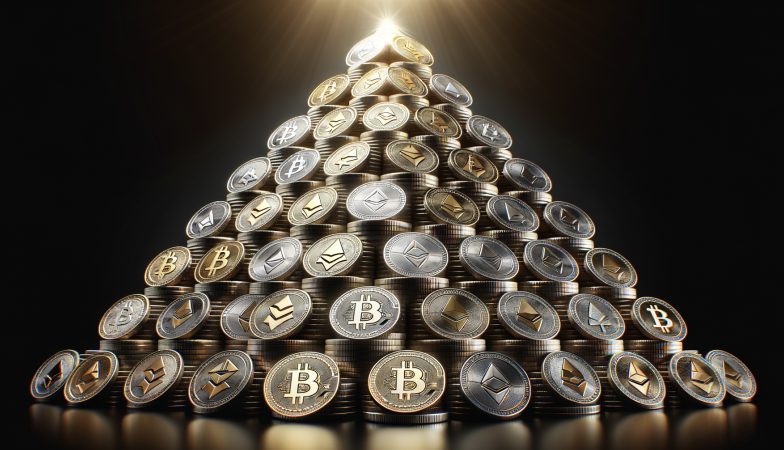Your guide: What is Cryptocurrency for Dummies?
An important question that many people have when they are new to the world of digital money is “What is cryptocurrency for dummies?” This book aims to make cryptocurrency easier for people who are new to it to understand by breaking it down into simple terms.
We will talk about its past, the technologies that make it work, its basic ideas, and how it works in the modern economy. This essay will give you a complete introduction to cryptocurrencies, whether you want to learn more about them, buy them, or use them.
Also read: What is Moo Deng Crypto?


What is Cryptocurrency (for Dummies)? Overview
To put it simply, cryptocurrency is a form of digital money that is encrypted for safety. When you use cryptocurrencies, they work on a decentralized network. This means that they are not controlled by a central body like banks or governments with traditional currencies. The fact that it is independent is mostly due to blockchain technology.
What Makes Cryptocurrency Unique?
Decentralization: Transactions are recorded in a blockchain, which is a public, shared log, and is checked by network nodes using encryption. This cuts costs and speeds up deals by getting rid of the need for middlemen.
- Security: Fraud and counterfeiting can’t happen with cryptocurrencies because they use complex cryptographic algorithms to stop the creation of new units and keep interactions safe.
- Anonymity: Transactions are recorded on a public ledger, but the names of the people involved may not be made public. This gives a level of privacy that isn’t usually possible with traditional financial systems.
- Global Access: Cryptocurrencies can be sent and received from anywhere in the world, so anyone with an internet link can use them. This is especially helpful for people who don’t have access to banks.
The Blockchain Explains How Cryptocurrency Works
The main technology that makes cryptocurrencies work is called blockchain. We call a digital record that keeps track of all the transactions that happen over a network of computers a blockchain.
How Does a Blockchain Work?
- Transaction Verification: When a transaction is started, it is sent to a network of computers, or nodes, to be checked. Together, these nodes make sure that the transaction is true.
- Making a Block: Once a transaction has been verified, it is put together into a block. Each block includes an encrypted hash of the block before it, which links them in order.
- Immutable Ledger: The transaction data is always correct because once a block is added to the blockchain, it can’t be taken down or changed.
What is Cryptocurrency (for Dummies)? Next, let’s focus on the Good Things
Transparency: The public log keeps track of all transactions, so anyone can see where the money goes.
- Security: Because blockchain is not controlled, it is less likely to be hacked or used for fraud than centralized systems.
- Efficiency: By cutting out middlemen, blockchain can cut transaction times and costs by a huge amount.


A Look Back at Cryptocurrency’s History
The idea of cryptocurrency has been around since the 1980s, but it wasn’t until 2009 that the modern era of cryptocurrencies began, when someone going by the name Satoshi Nakamoto created Bitcoin.
Important Events That Changed the Course of Cryptocurrency History David Chaum introduced eCash in 1983. It was the first digital cash that was made to protect people’s privacy online.
When Bitcoin first came out in 2009, it let people send money to each other without a central authority.
- 2011: Litecoin, a faster option to Bitcoin, is created. This is the start of many other coins, also called “altcoins.”
- 2016: Ethereum comes out, adding smart contracts to the platform. This makes cryptocurrencies more useful than just for transfers.
- 2021: Cryptocurrencies have a market value of more than $2 trillion, which shows that a lot of people accept them and investors are interested in them.


Different Kinds of Cryptocurrency
The Bitcoin market is diverse because there are many digital currencies to choose from. They can be broken down into a few main groups:
Coins vs. Tokens
There are different kinds of coins, like Ethereum and Bitcoin, each with its own blockchain that works with it.
Tokens: Often used as a stand-in for resources or services in an environment, tokens are built on top of blockchains that already exist. One example is Tether (USDT). Another is Chainlink (LINK).
Coins that won’t lose value
Stablecoins offer stable prices because they are tied to regular currencies or assets. They work great as a way to trade and swap money. DAI and USDC are two examples.
- NFTs, which stand for “non-fungible tokens”
- NFTs can’t be used to buy anything else, and they represent unique digital goods like art or collectibles. The things that make them valuable are how rare and unique they are.
How do cryptocurrencies work?
Everyone who wants to use digital currencies needs to know how exchanges work.
- Start of the Transaction Process: To begin a transaction, a person uses their cryptocurrency wallet, which holds their digital assets.
- Broadcasting: The network gets a report of the transaction so that it can be checked.
- Verification: Nodes in the network use complex cryptographic calculations to make sure the exchange is real.
- Recording: Once the transaction has been checked and approved, it is added to the blockchain.
- Finishing: The user’s wallet now shows the new amount after the transaction is done.
Checking that transactions are real and mining
Mining is the process of making new digital coins and making sure that transactions are safe. Users who are miners use their computers to solve hard math problems and are rewarded with cryptocurrency.
Also read: Blockchain for Beginners: What is it?
- Coins and Bitcoins purchases and sales
- For newcomers, getting into the Bitcoin market can be scary. Regardless, buying and selling cryptocurrency is an easy process.
- Making a Wallet for Cryptocurrency
- Before you can buy coins, you need a digital wallet to store your cash. There are two main types of wallets:
- Hot wallets: These are simple to use and can connect to the internet, so they can be used for everyday activities.
- Cold wallets are offline storage choices that protect assets better and keep them safe for longer.


How to Choose a Crypto Exchange?
When buying and selling cryptocurrencies, it’s important to pick a cryptocurrency market that you can trust. Exchanges with a good reputation, like Coinbase and Binance, let you buy and sell a lot of different cryptocurrencies.
Putting transactions through
If you want to buy cryptocurrency, you usually need to do the following:
- Open an account on a coin exchange.
- Money from the real world or another coin can be used to add money to your account.
- Choose the cryptocurrency you want to buy, and then finish the deal.
How to Keep Cryptocurrency Safe?
Protecting your digital assets is very important after you buy in cryptocurrency.
- Hardware wallets are a good way to store things. Hardware wallets, like Trezor or Ledger, are best for long-term storage because they keep your secret keys away from your computer.
- Protect Your Recovery Phrases and Private Keys: Keep your recovery phrases and private keys in a safe place at all times. If you lose your money, you might never get it back.
- Don’t store things on exchanges. Exchanges make it easy to store things, but hackers often target them.
So, why bother with crypto at all?
Cryptocurrency brings both opportunities and challenges to both customers and investors.
- Lower transaction costs: Because cryptocurrencies cut out middlemen, they can cut transaction fees by a large amount.
- Accessibility: Anyone with an internet link can use cryptocurrencies, which promotes financial inclusion.
- Chance to Make a Lot of Money: Many people have made a lot of money by investing in cryptocurrencies, especially Bitcoin and Ethereum.
- Cons of Cryptocurrency Volatility: The cryptocurrency market is known for being very unstable, with price changes that can cause big losses.
- Regulatory Issues: Because there aren’t enough rules, investors may be open to theft and scams.
- Effects on the climate: Ethereum mining uses a lot of electricity, which makes some people worry about how it will affect the climate.
What does the future of crypto look like?
It looks to still be a world that is not explored. If we zoom out by 90 years, we’re probably just at the very beginning of it all.
- Trends to Keep an Eye On: More rules and laws As coins become more well-known, governments will likely pass laws to protect investors and stop fraud.
- Adoption by Institutions: Cryptocurrencies could become widely used if more businesses and banking institutions start to accept them.
- Changes in Technology: Cryptocurrency will be safer and easy to use as blockchain technology gets better.
Conclusion: What is Cryptocurrency (for Dummies)?
Cryptocurrency isn’t just a fad; it’s a change in the way we think about goods and money. If you know what cryptocurrency is, how it works, and how it might change finance, you can feel safe in this new and exciting world.




